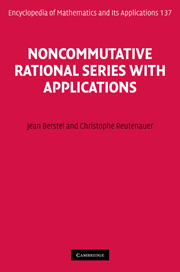3 - Series and languages
from Part I - Rational series
Published online by Cambridge University Press: 05 June 2013
Summary
This chapter describes the relations between rational series and languages.
We start with Kleene's theorem, presented as a consequence of Schützenberger's theorem. Then we describe the cases where the support of a rational series is a rational language. The most important result states that if a series has finite image, then its support is a rational language (Theorem 2.10).
The family of languages which are supports of rational series have closure properties given in Section 3.4. The iteration theorem for rational series is proved in Section 3.5. The last section is concerned with an extremal property of supports which forces their rationality; to prove it, we use a remarkable characterization of rational languages due to Ehrenfeucht, Parikh and Rozenberg.
Kleene's theorem
Definition A congruence in a monoid is an equivalence relation which is compatible with the operation in the monoid. A language L is recognizable if there exists a congruence with finite index in A* that saturates L (that is L is a union of equivalence classes).
It is equivalent to say that L is recognizable if there exists a finite monoid M, a morphism of monoids ϕ: A* → M and a subset P of M such that L = ϕ−1(P).
The product of two languages L1 and L2 is the language L1L2 ={xy∣x ϵ L1, y ϵ L2}. If L is a language, the submonoid generated by L is ∪n≥0Ln.
- Type
- Chapter
- Information
- Noncommutative Rational Series with Applications , pp. 47 - 64Publisher: Cambridge University PressPrint publication year: 2010



